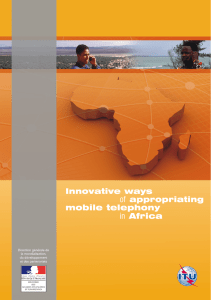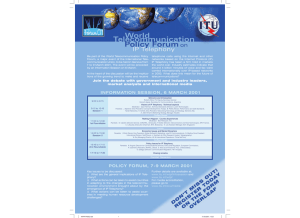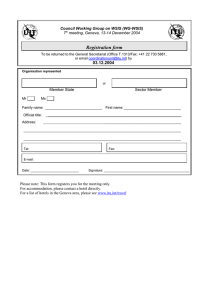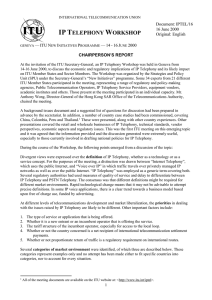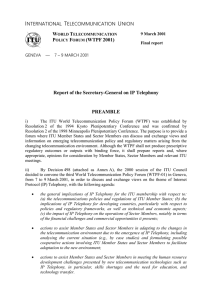ITU INTERNET REPORTS 2001: IP ...
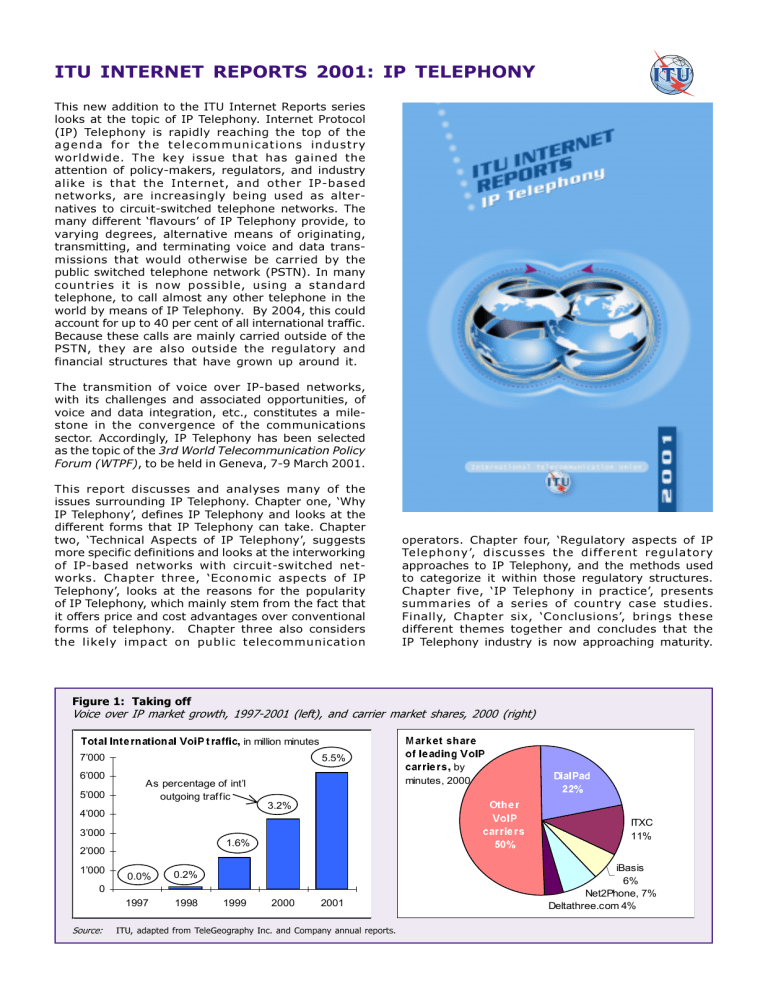
ITU INTERNET REPORTS 2001: IP TELEPHONY
This new addition to the ITU Internet Reports series looks at the topic of IP Telephony. Internet Protocol
(IP) Telephony is rapidly reaching the top of the agenda for the telecommunications industry worldwide. The key issue that has gained the attention of policy-makers, regulators, and industry alike is that the Internet, and other IP-based networks, are increasingly being used as alternatives to circuit-switched telephone networks. The many different flavours of IP Telephony provide, to varying degrees, alternative means of originating, transmitting, and terminating voice and data transmissions that would otherwise be carried by the public switched telephone network (PSTN). In many countries it is now possible, using a standard telephone, to call almost any other telephone in the world by means of IP Telephony. By 2004, this could account for up to 40 per cent of all international traffic.
Because these calls are mainly carried outside of the
PSTN, they are also outside the regulatory and financial structures that have grown up around it.
The transmition of voice over IP-based networks, with its challenges and associated opportunities, of voice and data integration, etc., constitutes a milestone in the convergence of the communications sector. Accordingly, IP Telephony has been selected as the topic of the 3rd World Telecommunication Policy
Forum (WTPF) , to be held in Geneva, 7-9 March 2001.
This report discusses and analyses many of the issues surrounding IP Telephony. Chapter one, Why
IP Telephony, defines IP Telephony and looks at the different forms that IP Telephony can take. Chapter two, Technical Aspects of IP Telephony, suggests more specific definitions and looks at the interworking of IP-based networks with circuit-switched networks. Chapter three, Economic aspects of IP
Telephony, looks at the reasons for the popularity of IP Telephony, which mainly stem from the fact that it offers price and cost advantages over conventional forms of telephony. Chapter three also considers the likely impact on public telecommunication operators. Chapter four, Regulatory aspects of IP
Telephony, discusses the different regulatory approaches to IP Telephony, and the methods used to categorize it within those regulatory structures.
Chapter five, IP Telephony in practice, presents summaries of a series of country case studies.
Finally, Chapter six, Conclusions, brings these different themes together and concludes that the
IP Telephony industry is now approaching maturity.
Figure 1: Taking off
Voice over IP market growth, 1997-2001 (left), and carrier market shares, 2000 (right)
7RWDO,QWHUQDWLRQDO9RL3WUDIILF
in million minutes
7’000 5.5%
6’000
5’000
4’000
As percentage of int’l outgoing traf fic
3.2%
3’000
2’000
1’000
0
0.0% 0.2%
1.6%
1997 1998 1999 2000 2001
0DUNHWVKDUH
RIOHDGLQJ9R,3
FDUULHUV
by minutes, 2000
2WKHU
9R,3
FDUULHUV
'LDO3DG
ITXC
11% iBasis
6%
Net2Phone, 7%
Deltathree.com 4%
Source: ITU, adapted from TeleGeography Inc. and Company annual reports.
Much of the research for this report was carried out under the New Initiatives programme, launched at the ITU in 1999. The research program included the case studies and a workshop on IP Telephony in
Geneva on 14-16 June 2000 (see: www.itu.int/iptel).
The ITU is committed to playing a positive role in the development of the Internet and to extending the benefits of new telecommunication technologies, such as the Internet, to all the world's inhabitants.
The Minneapolis Plenipotentiary Conference (1998) passed Resolution 101, which calls upon the ITU to
"fully embrace the opportunities for telecommunication development that arise from the growth of IP-based services." The ITU Internet Reports are hopefully a significant contribution to that commitment.
Figure 2: Internet host distribution
,QWHUQHWKRVWGLVWULEXWLRQE\UHJLRQ-XO\
Pacific
3.3%
Europe
24.0%
Asia
11.1%
Af rica
0.4%
Americas
61.2%
Source : ITU, partially based on data from the Internet Software
Consortium (www.isc.org) and RIPE (www.ripe.net).
Table 1: Multimedia access
Economies rank based on the cumulative score in Teledensity, TVs, Internet hosts, and Cellular mobile density
Czech Republic
Korea (Rep.)
7HOHSKRQHPDLQ
OLQHGHQVLW\SHU
LQKDELWDQWV
37.1
44.1
79VHWVGHQVLW\
SHU
LQKDELWDQWV
,QWHUQHWKRVW
GHQVLW\SHU
LQKDELWDQWV
&HOOXODUPRELOH
VXEVFULEHUGHQVLW\
SHULQKDELWDQWV
2YHUDOO
5DQN (FRQRP\
United States
United Kingdom
Hongkong SAR
New Zealand
68.2
57.5
57.6
49.0
5DQN 5DQN 5DQN 5DQN
5 1’694.55 3 61.75
10 1’850.51 2 65.12 1
12 1’134.50 6 49.47 10
9 1’895.69 1 61.93
8 84.90 2 1’386.99 4 31.15 25
10 1’116.40 7 58.29
18 1’011.21 9 43.54 17
16 64.5 9 549.93 18 13
7
5
1’028.81
976.98
8
10
34.28 22
22.65 35
26 714.00 12 41.08 19
27 371.81 24 44.94
13 313.22 26 36.40 20
15 43.40
4 38.9
27
38
17
50
583.87
305.00
361.48
399.91
16
28
25
21
51.44
63.61
8
2
28.57 28
48.70 11
20
28
41.60 41
51.20
24
28
30
21
48
34
482.19 19 7
582.19
1’262.38
17
5
31.45
23.01
23
34
142.60
149.22
298.40
40
37
28
52.83
46.81
45.67
6
12
15
50
38
46.70
60
35
34.60 57
42
128.14 42 31.06 26
201.80 31 24
424.95 21 45.89 14
679.92 15 18
205.32 31 18.95 46
44.92 61 9
200.76 33 49
81.25 46 10.21 65
69.49 50 58
Turkey
Chile
Brazil
Mexico
Malaysia
South Africa
Russia
Venezuela
Thailand
China
Philippines
Indonesia
India
26.5 66
20.7 81
14.9 95
11.2 101
20.3 84
13.8 97
20.6 82
10.9 103
8.6 115
8.6 114
4.0 140
2.9 118
2.7 140
31.50 65
23.60 91
32.40 61
26.10 80
17.00 111
13.40 120
42.10 39
18.50
24.00
28.70
107
86
71
11.00 128
13.60 118
7.50 140
22.02 72 60
47.74 59 51
47.41 60
74.19 49
8.95 70
48.23 58 13.70 54
13.21 55 74.96 48
15.78 78
10.75
11.78
1.01
94
91
133
2.97 113
1.79 121
0.42 148
14.34
3.84
3.42
1.06
52
94
97
123
Source: ITU, partially based on data from the Internet Software Consortium (www.isc.org) and RIPE (www.ripe.net).
To purchase the report, please contact:
ITU - Sales and Marketing Service
Place des Nations
CH-1211 Geneva 20 - Switzerland Visit us at: http://www.itu.int/ti/index.htm
Telefax: +41 22 730 51 94
E-mail: sales@itu.int
